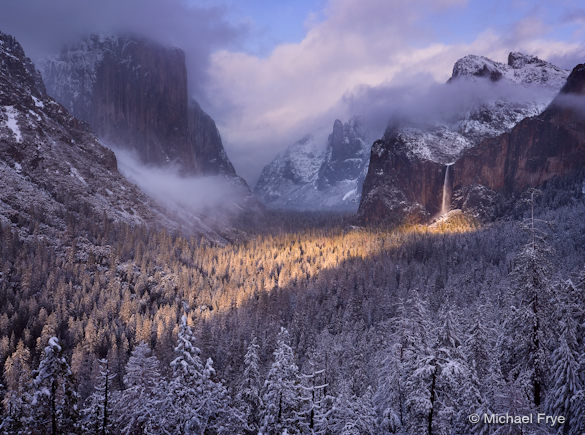by Michael Frye | Oct 27, 2010 | Yosemite Photo Conditions
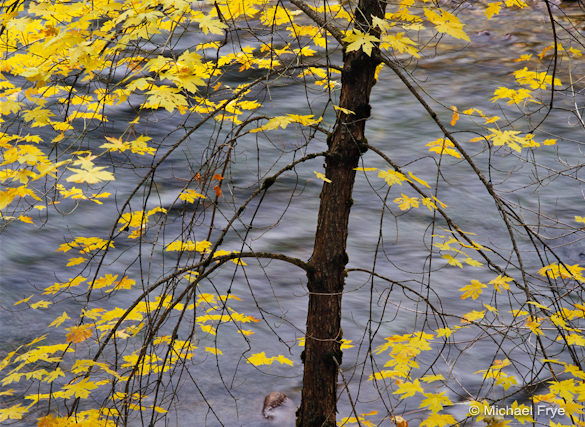
Big-leaf maple… from a few years ago
Fall Color in Yosemite Valley is late—really late. I reported last week that about 50 percent of the maple leaves had turned, 20 percent of the cottonwoods, 20 percent of the dogwoods, and 5 percent of the oaks. Well it’s nearly a week later and I’d say the percentages are the same! Hardly anything has changed. There is some good color in spots: as before, the best places are around Pohono Bridge and underneath Cathedral Rocks along Southside Drive. I heard a reliable report that the dogwoods along Highway 120 are about half turned.
At this point don’t want to even try to predict when the color will peak, or what kind of autumn it might be, as this season is progressing more slowly than any fall I can remember. I’ll let you know if things suddenly start to turn.
by Michael Frye | Oct 26, 2010 | Critiques
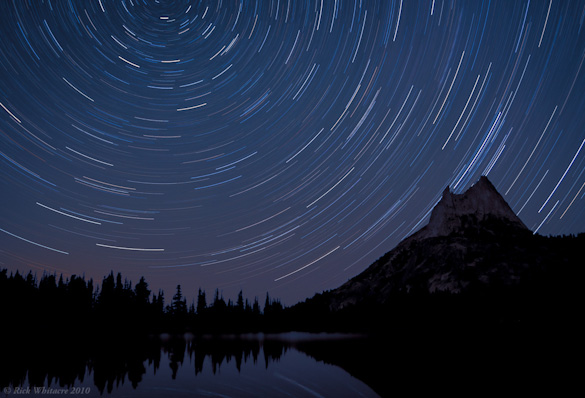
Star Trails and Cathedral Peak by Rick Whitacre
This week’s photograph was made by Rick Whitacre at Upper Cathedral Lake in Yosemite. By having his image chosen for this critique Rick will receive a free 16×20 matted print from Aspen Creek Photo. If you’d like your images considered for future critiques you can upload them to the Flickr group I created for this purpose.
When I saw this image among the submissions for this series, it occurred to me that I hadn’t critiqued a nighttime photograph before, and that doing so might help provide some lessons and insights into night photography.
(more…)
by Michael Frye | Oct 25, 2010 | Vision and Creativity
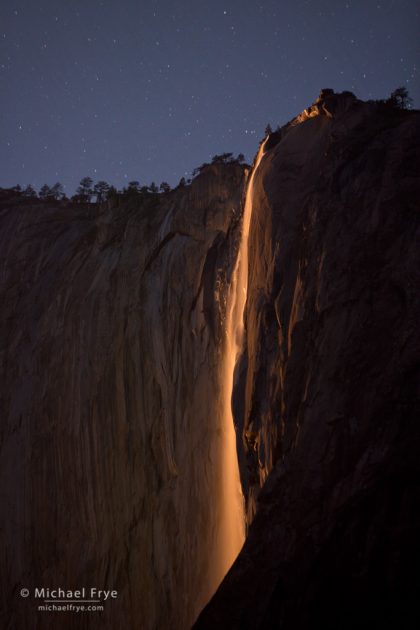
Horsetail Fall by moonlight, Yosemite NP, CA, USA
Horsetail Fall has become a celebrity, attracting more lenses than Brangelina. In February hundreds of photographers try to catch the fleeting sunset light on this little waterfall. Suitable vantage points are limited, so it’s hard to find new and different ways to portray this iconic subject. But it occurred to me that if I could catch the moon setting at just the right angle I might be able to photograph it at night.
It turns out that the right conditions for moonset light on Horsetail Fall are quite rare. The moon’s path varies greatly as it waxes and wanes. It has to set at the right angle while close to full (to provide enough light), before sunrise (so the dawn light doesn’t wash out sky), and there has to be water in the fall. Such conditions may occur only once every other year, at most.
Fortunately I found perfect conditions last spring. As I walked up to one of my favorite Horsetail Fall viewing locations at about 4 a.m., I saw an amazing sight: that beautiful, low-angle backlight on the waterfall, with the cliff behind it in the shade. It looked exactly like it does at sunset in February, only with stars in the sky above it.
Our eyes can’t see color in the dark, but cameras can, so as soon as I made my first test exposure I could see that now-classic orange glow on my LCD screen. I used both short and long shutter speeds, but ended up liking the short ones, with pinpoint stars, best.
This photograph was selected to be part of the Best of Nature show at the Ordover Gallery in the San Diego Natural History Museum. Two more of my images, Winter Sunrise From Tunnel View, and Winter Morning Along the Merced River, were also chosen. The opening reception is November 13th, 11 a.m. to 1 p.m., and will be on view until January 30, 2011. Hope to see some of you at the reception!
Speaking of Horsetail Fall, right now is it’s mirror season. The light is identical to February, and the only reason hundreds of photographers don’t try to photograph it in October is because there’s usually no water in the fall. But Yosemite Valley received almost four inches of rain in the last 48 hours, so there should be plenty of water in Horsetail Fall for the next day or two.
by Michael Frye | Oct 22, 2010 | Announcements, Workshops
Spotlight on Bridalveil Fall, Yosemite National Park
The Ansel Adams Gallery posted their 2011 workshops on their web site today, and they’re open for registration. I’m very happy to announce that I’ll be teaching five classes with the Gallery next year, including a Photoshop and Digital Printing Workshop in January, the Spring Yosemite Digital Camera Workshop in April, and my Hidden Yosemite workshop in July. You can see the complete list on myworkshop page.
There are a few errors on the Gallery’s site, which we’re working to fix. The descriptions on my site are correct, so please refer to these for now, and email me if you have any questions. But I wanted to let you all know that the registration is open, since these classes often fill up quickly.
As you probably know from reading this blog, I love teaching. It’s immensely satisfying to help people find their photographic vision and master the craft of photography. So I’m really looking forward to these workshops next year! Hope to see you in one of them.
by Michael Frye | Oct 21, 2010 | Yosemite Photo Conditions
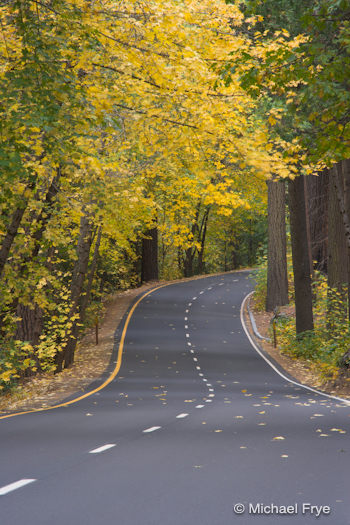
I spent the last two days in Yosemite Valley doing a private workshop. The weather was fantastic—we got to photograph lots of interesting clouds and chiaroscuro light patterns. More potentially photogenic stormy conditions are predicted through the weekend.
The autumn color in the valley is improving every day, but it’s still not quite there yet. There are four main types of deciduous trees in the valley: big-leaf maples, dogwoods, cottonwoods, and black oaks. The maples usually change color first, and this year is no exception. You can find nice displays already near Pohono Bridge and along Southside Drive underneath Cathedral Rocks. I’d say about 50 percent of the maple leaves in the valley have turned as of today.
The other trees are a bit further behind. Perhaps 20 percent of the dogwood and cottonwood leaves have changed so far, and perhaps only 5 percent of the oak leaves. The dogwoods and cottonwoods need at least another week, and the oaks maybe two weeks.
But while the show consists mostly of maples so far, these trees produce the most consistently vibrant and beautiful color in the valley, and they are changing rapidly. I saw a noticeable increase in yellow leaves in just the last 36 hours. So they may peak soon—maybe even this weekend.




